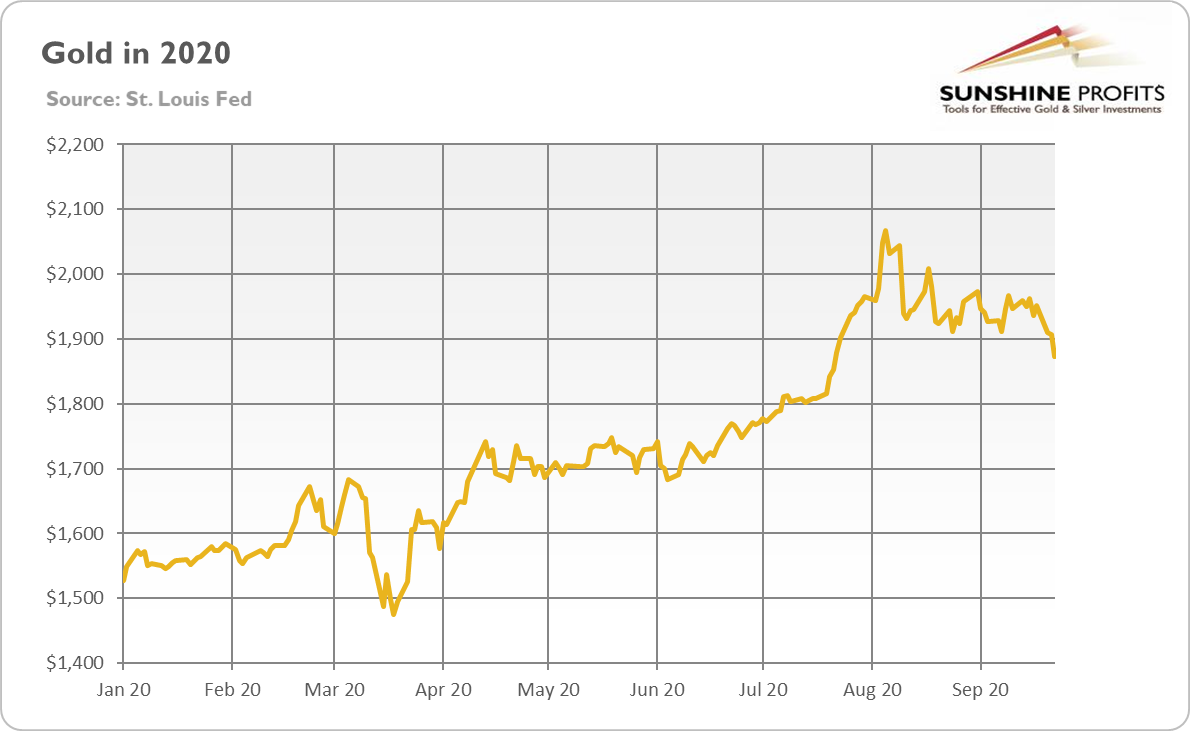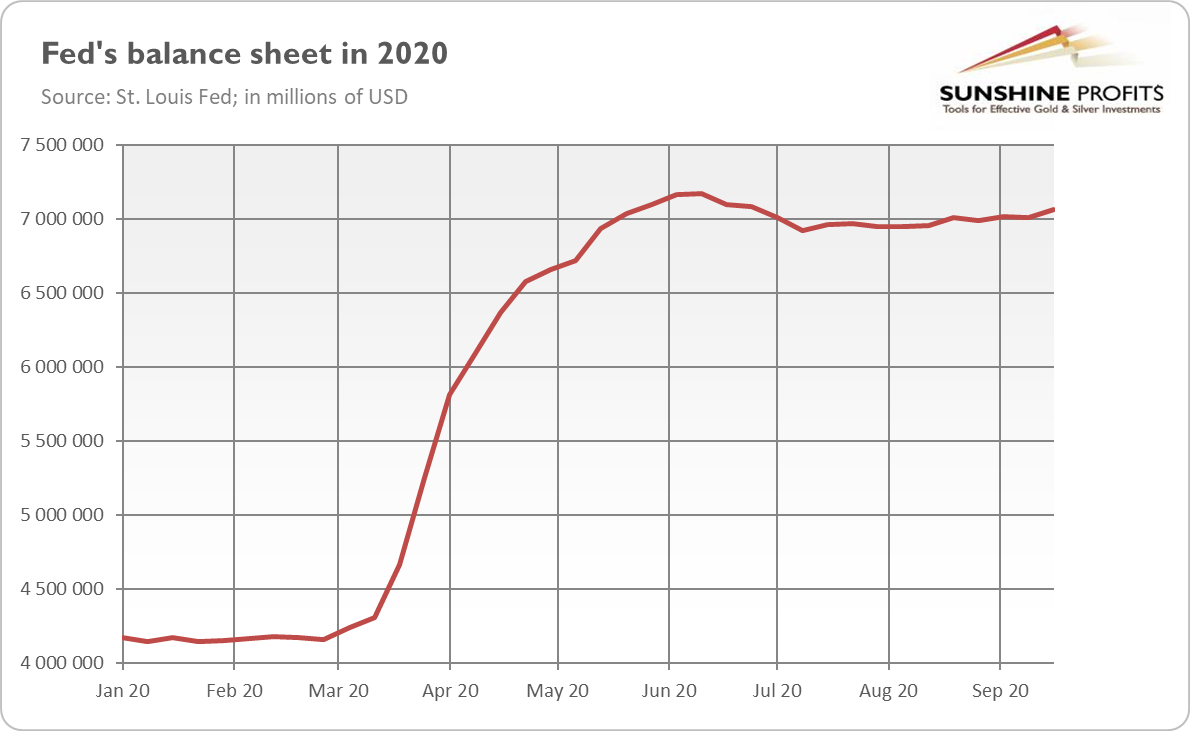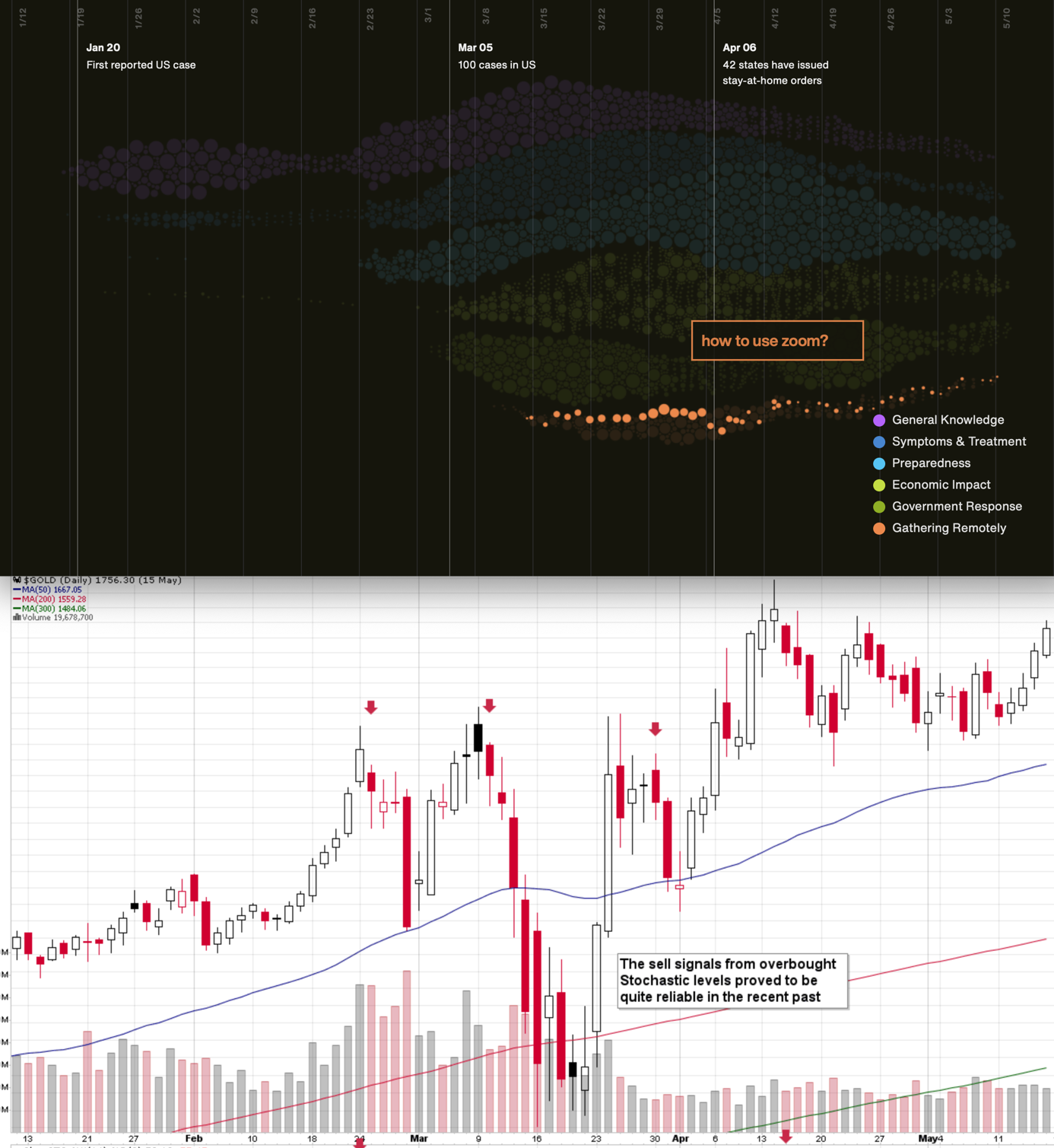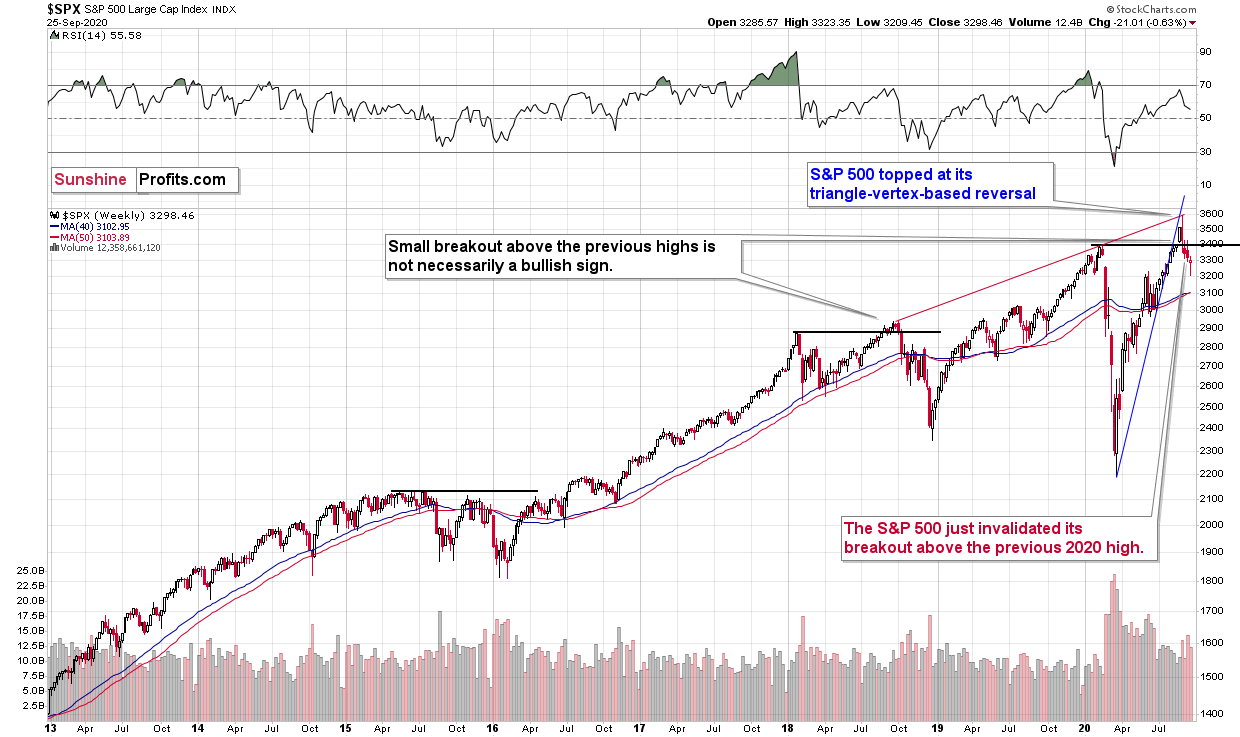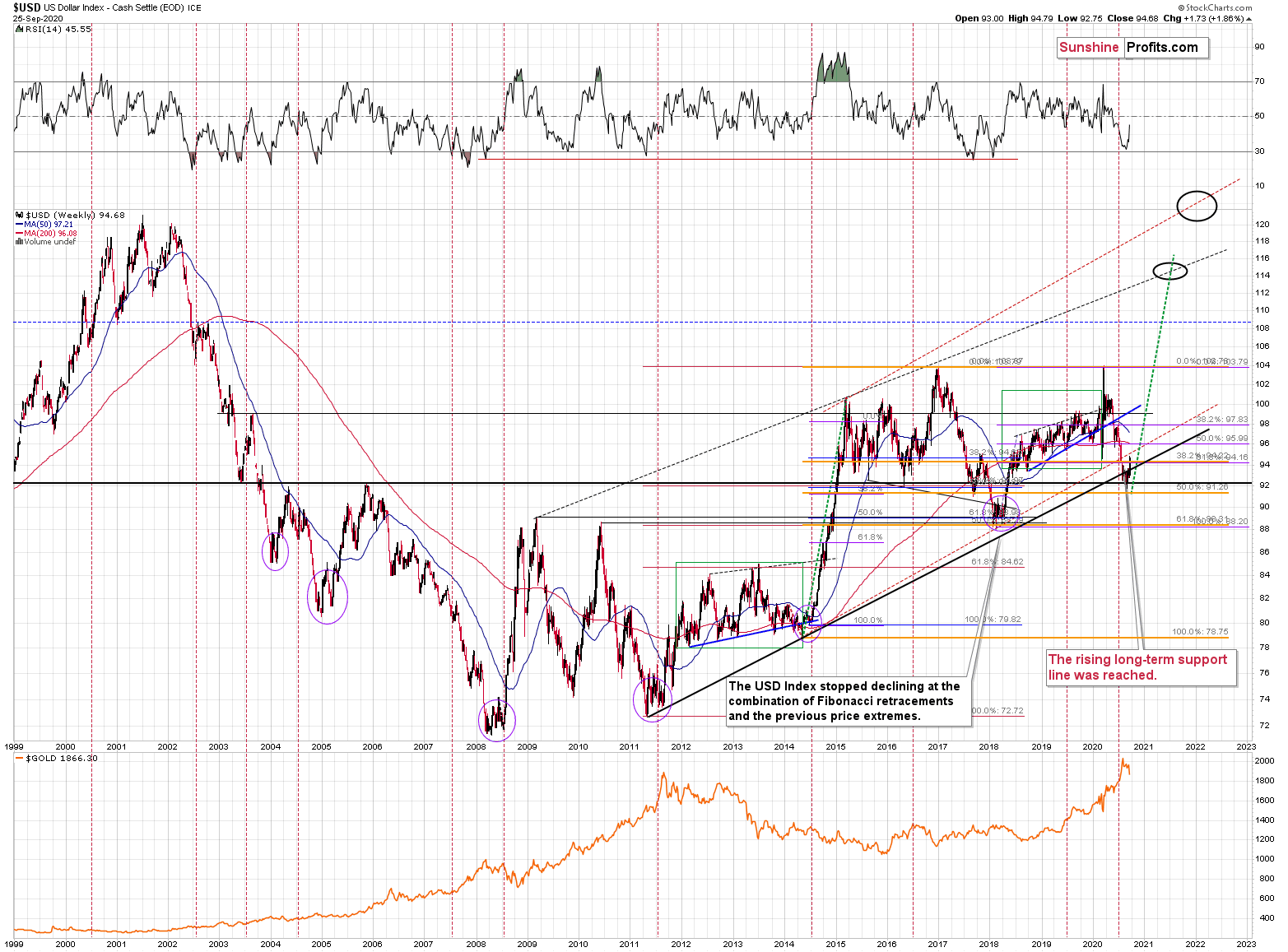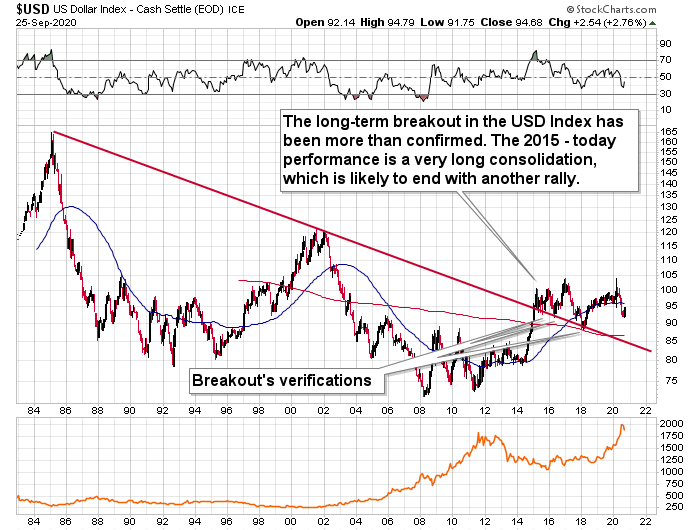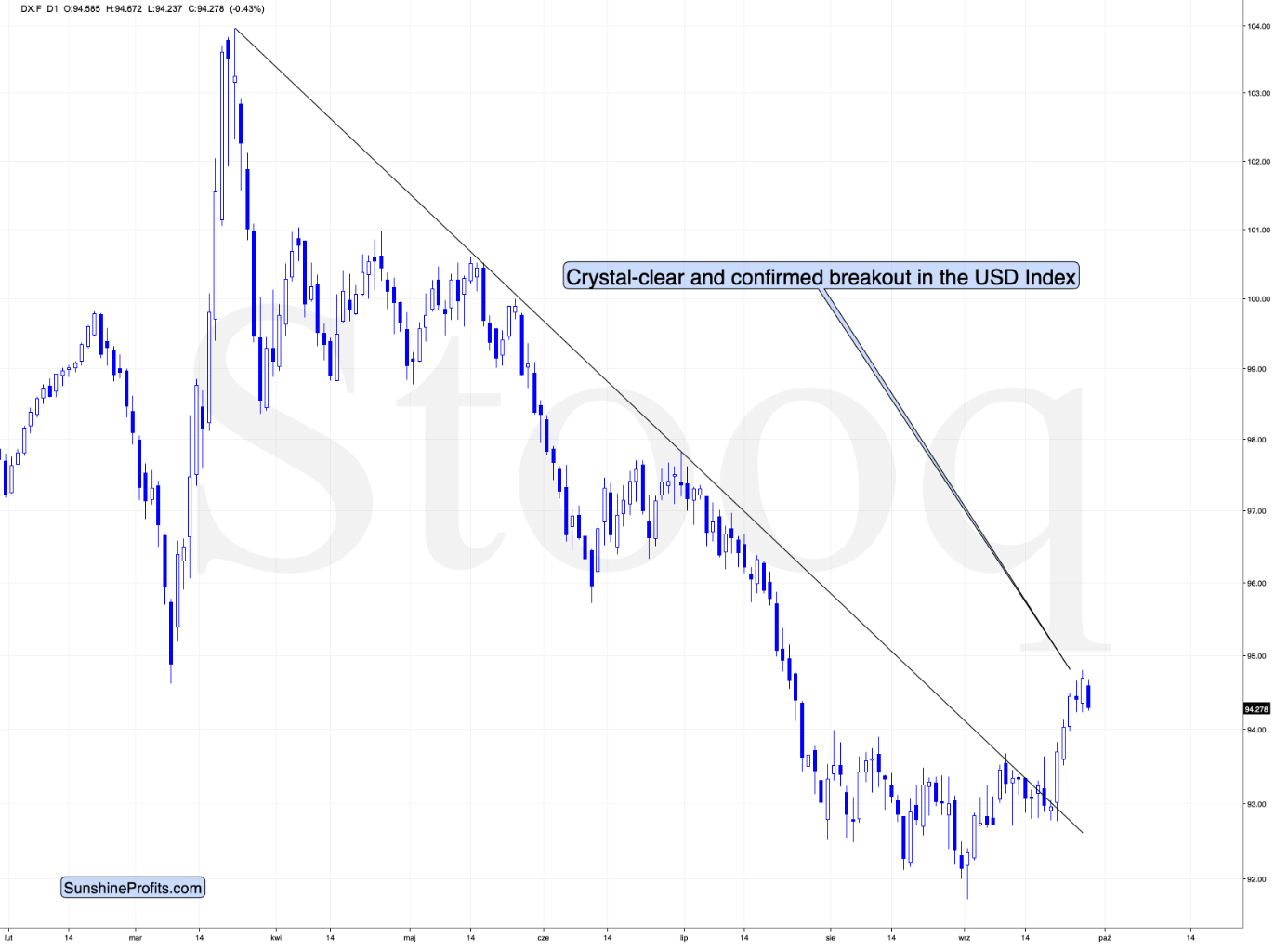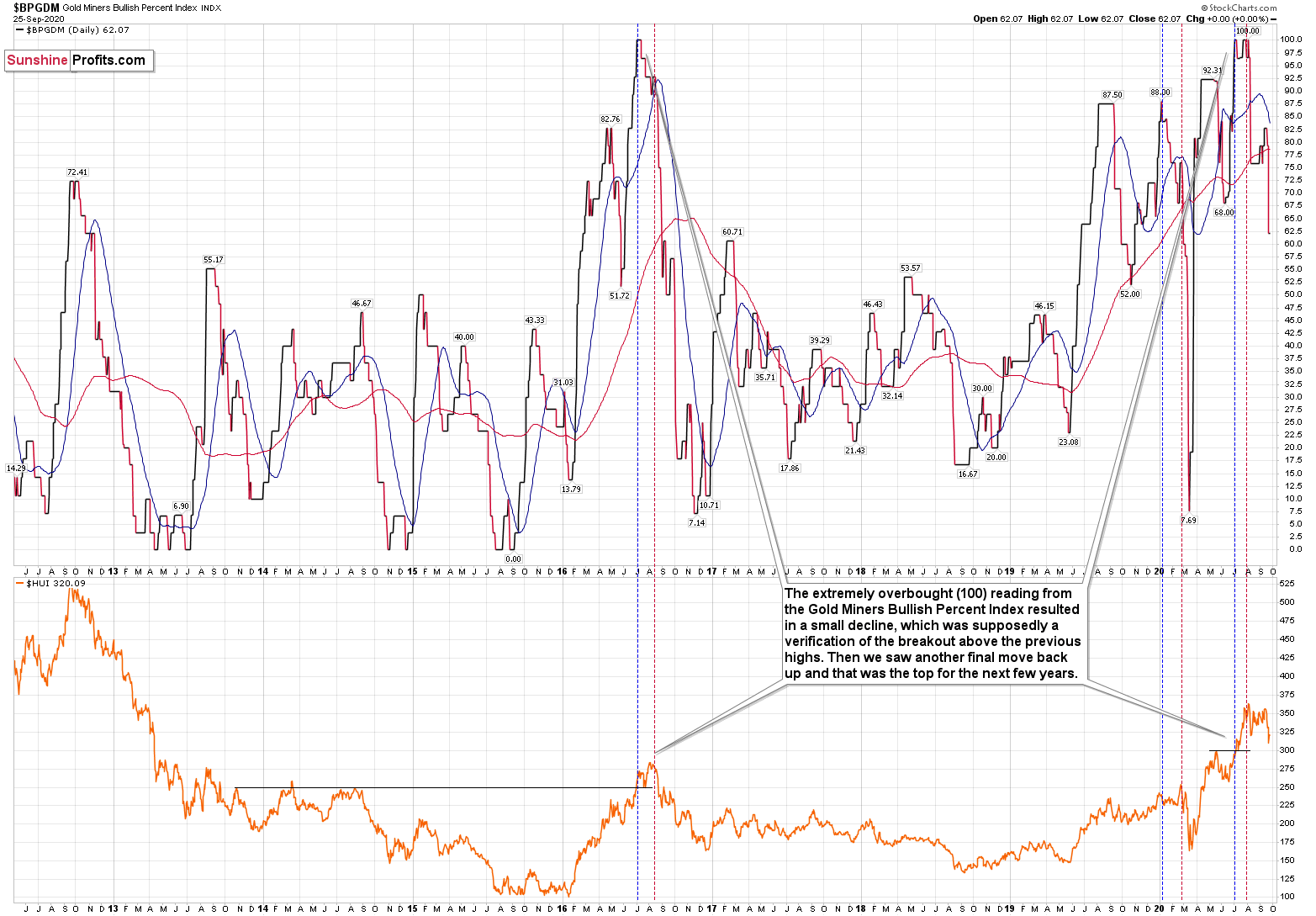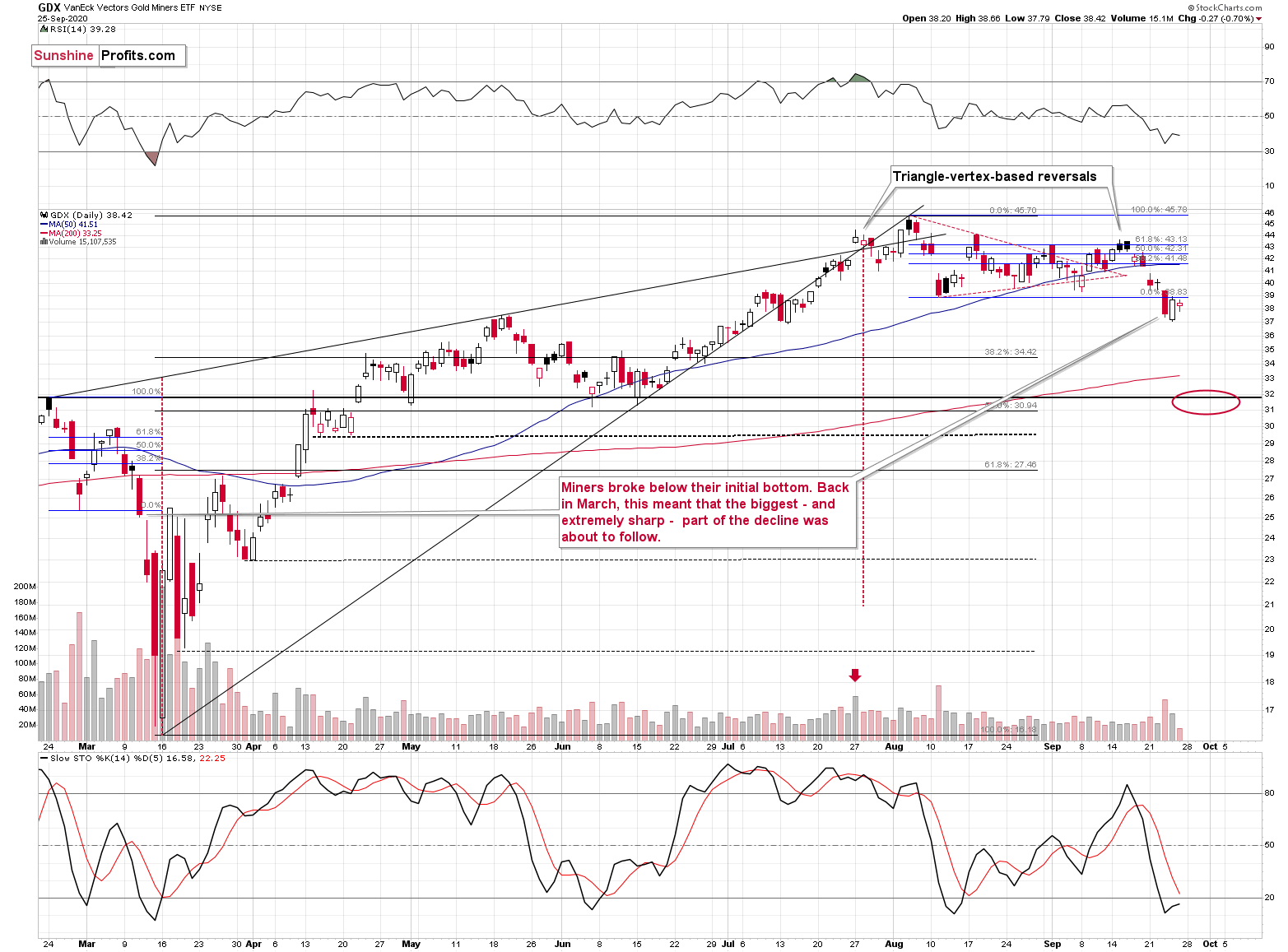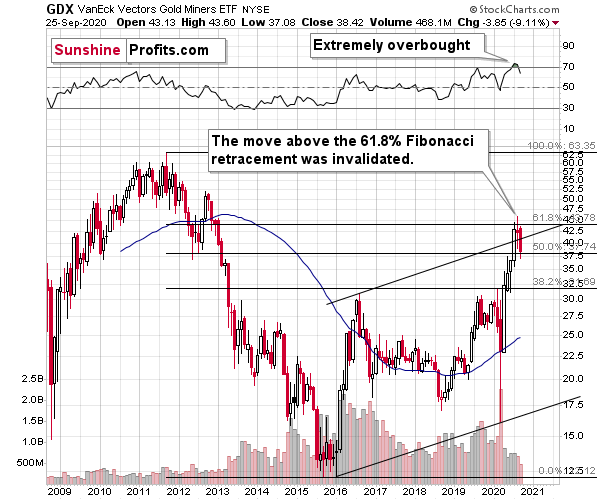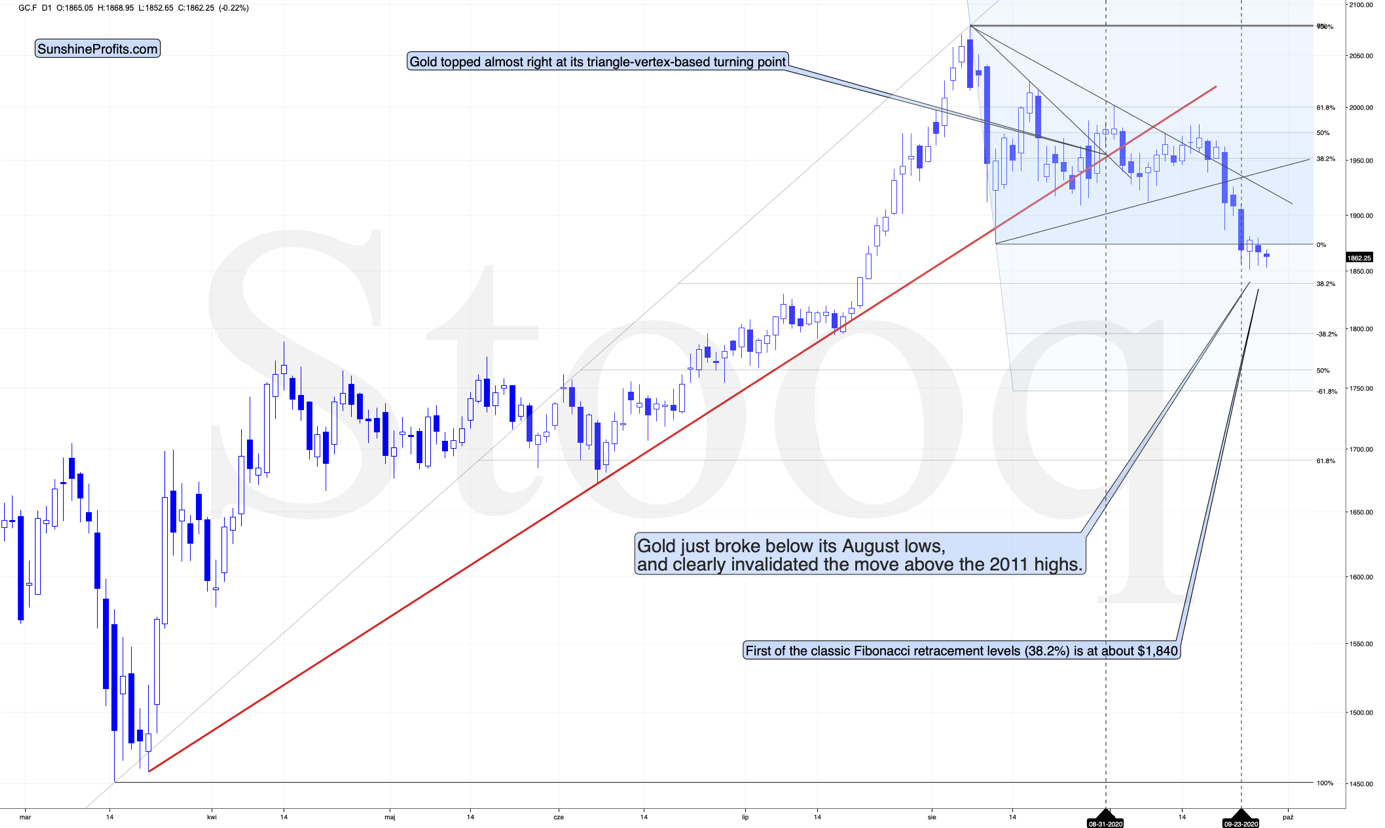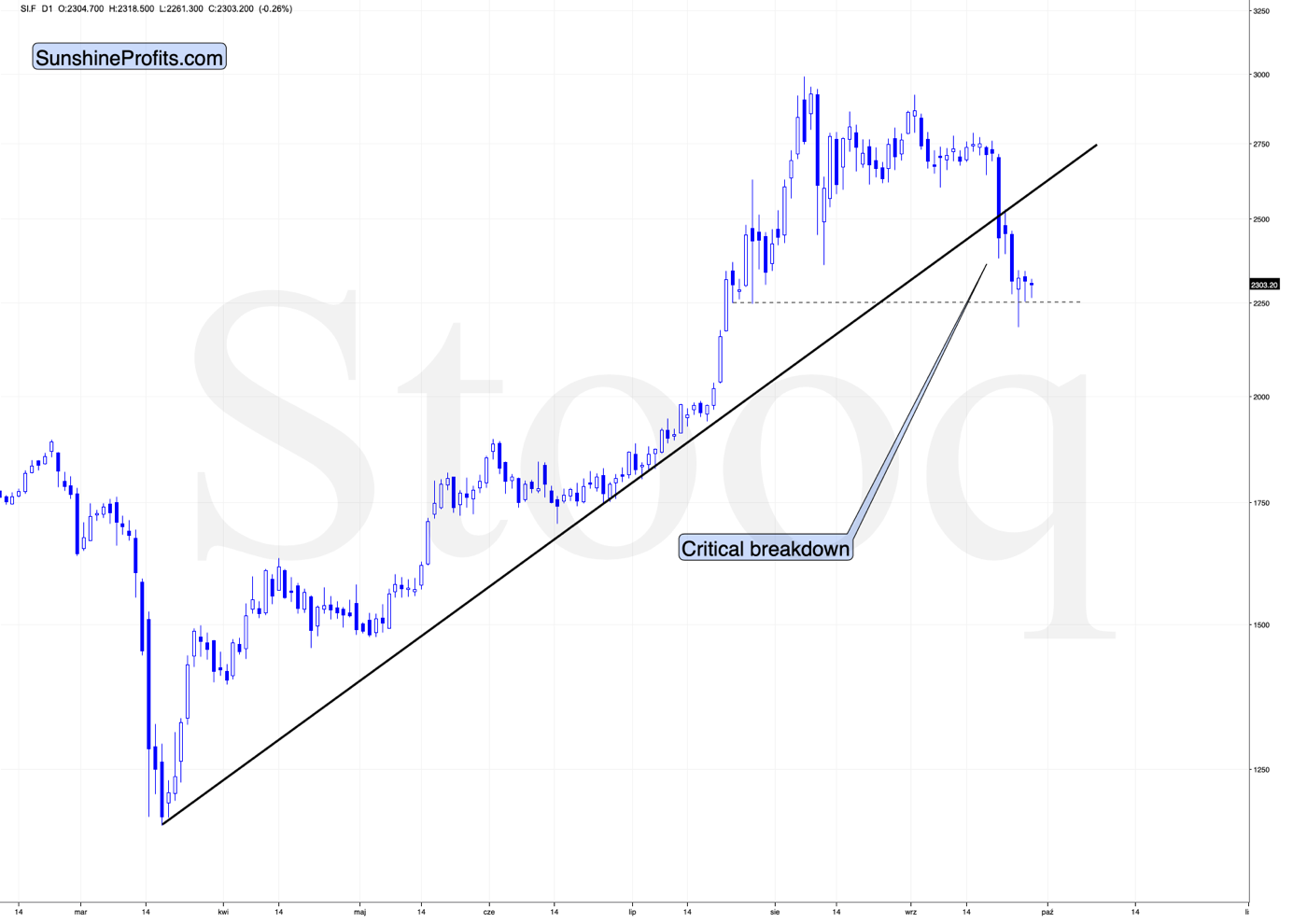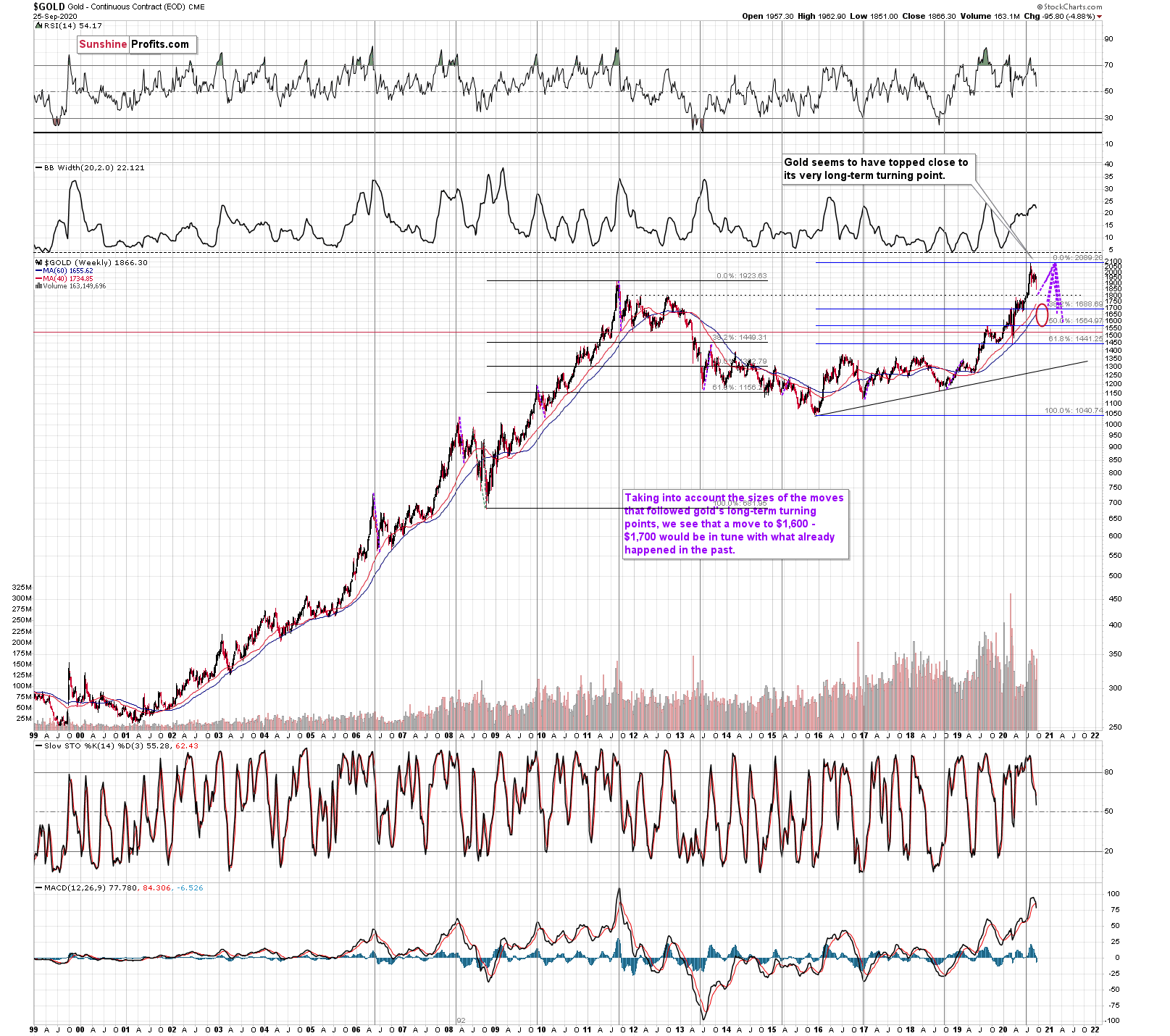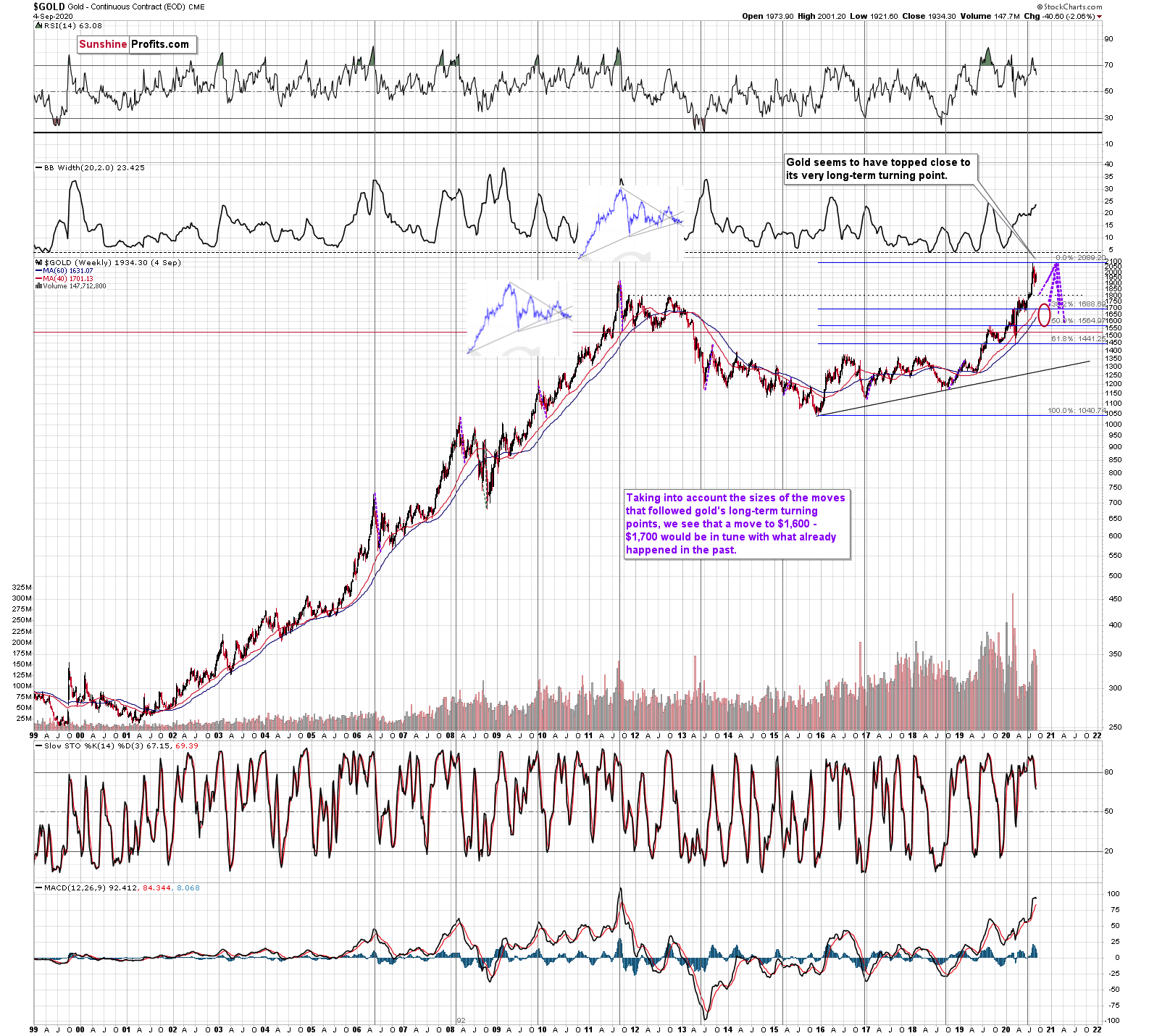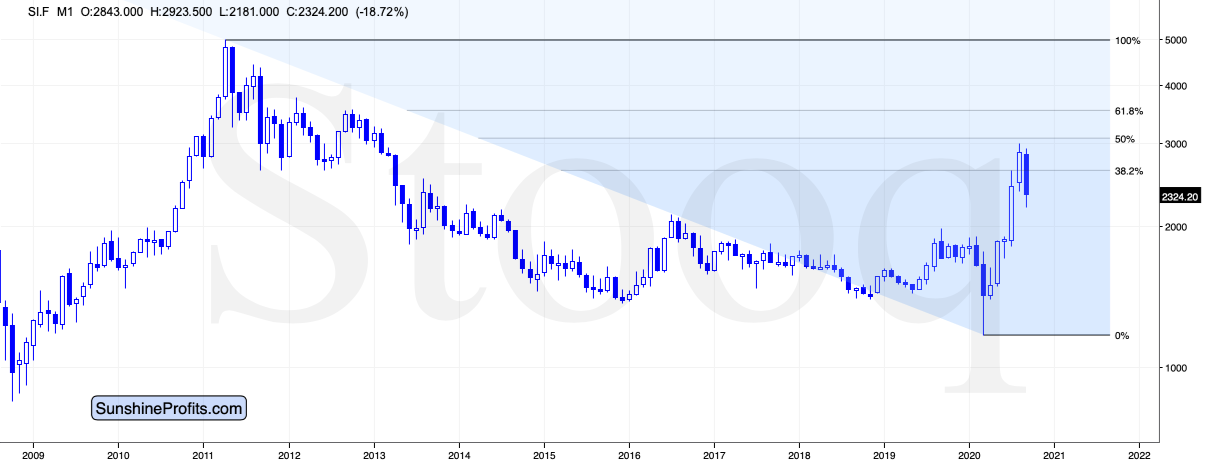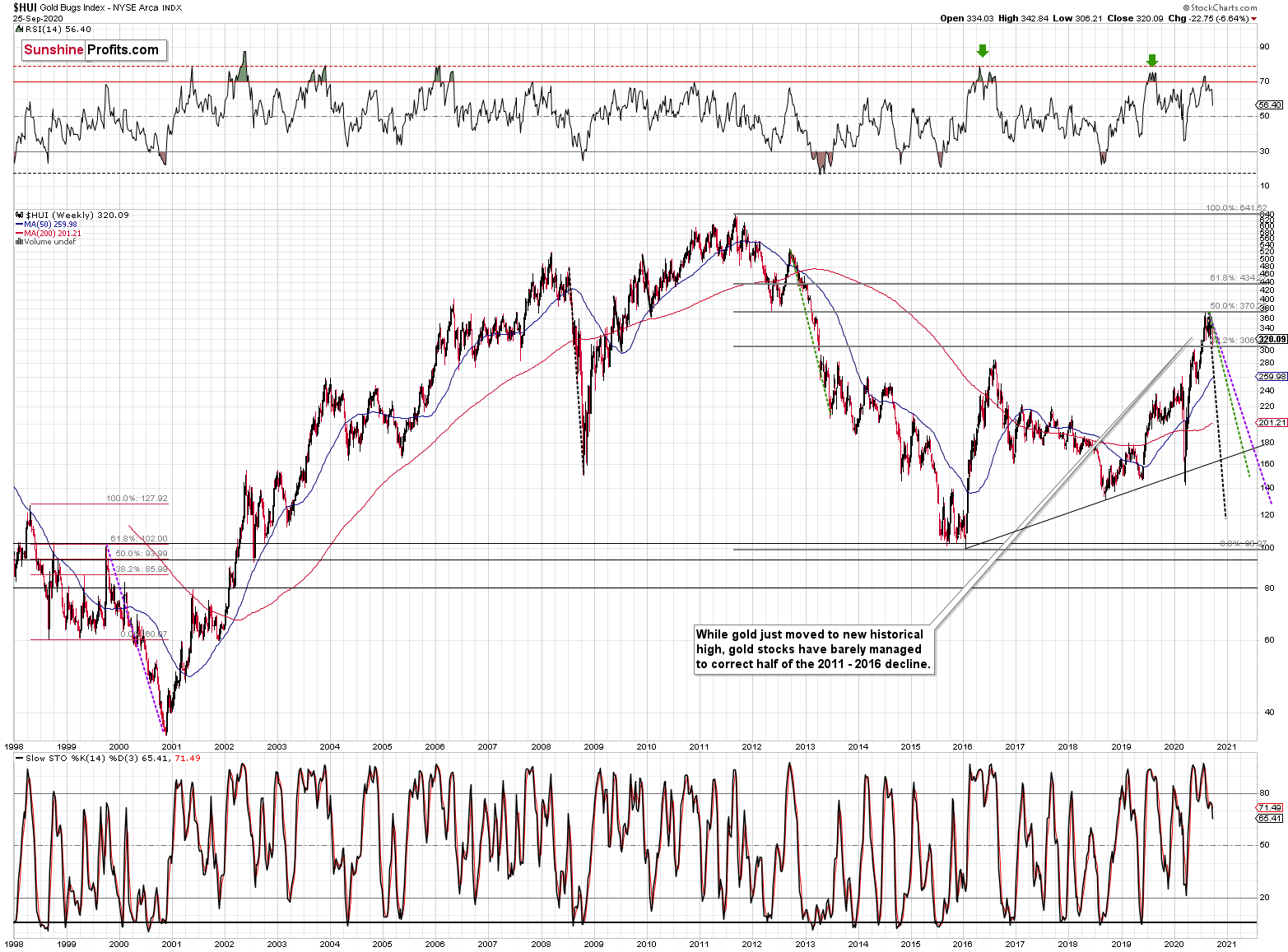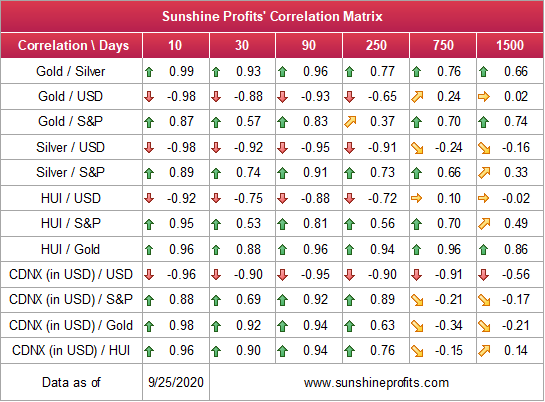Briefly: in our opinion, full (300% of the regular position size) speculative short positions in mining stocks are justified from the risk/reward point of view at the moment of publishing this Alert. We are moving back to our previous exposure given another breakout in the USD Index.
Welcome to this week's flagship Gold & Silver Trading Alert. As we've promised you previously, in our flagship Alerts, we will be providing you with bigger, much more complex analyses (approximately once per week) which will usually take place on Monday.
Based on last week's price moves, our most recently featured outlook didn't change as the prices generally moved in tune with our expectations. Consequently, there are parts of the previous analysis that didn't change at all in the previous days, which will be written in italics.
Before discussing the technical point of view, we'd like to say a few words on the recent fundamental developments. This time, we'll stay concentrated on Fed's indications.
The Fed Vice Chair says that the Fed will not even think about hiking interest rates until the inflation reaches 2 percent. In the meantime, the price of gold decreased further. So, what is exactly happening in the gold market?
Over the last week, several Fed officials spoke publicly with the purpose of convincing investors that their new policy strategy would be favorable for the economy. Powell himself testified three times before Congress. However, the most interesting remarks were delivered by Richard Clarida, Fed Vice-Chair.
On Wednesday, he told Bloomberg Television that the FOMC would not even think about hiking the federal funds rate until the inflation reaches 2 percent:
Rates will be at the current level, which is basically zero, until actual observed PCE inflation has reached 2%. That's 'at least.' We could actually keep rates at this level beyond that. But we are not even going to begin thinking about lifting off, we expect, until we actually get observed inflation ... equal to 2%.
That's brilliant news for the gold market! Clarida's words imply lower interest rates for a longer period. The Fed will not raise the rates until the labor market recovers completely, and the inflation at least hits the Fed's target, or until it somehow surpasses it for some time. According to US central bankers, these conditions will not be fulfilled until the end of 2023, if not later. The dovish monetary policy of lower for longer means that the real interest rates will likely stay in negative territory, supporting gold in the process, but that does not bear any yield. Moreover, if the inflation rises, the real interest rates will decline even further.
However, if this is that positive for the gold market, why does the yellow metal price has declined further below $1,900, as the chart below illustrates?
Well, the interest rate policy is only one aspect of the Fed's standpoint. Another one is the asset-buying program - and this is the one area where the US central bank disappointed the investors. You see, market participants were upset because the Fed did not announce the bond purchases expansion. Or they might have simply reacted for technical reasons - gold rallied too far and too fast, and it had to decline. It's impossible to tell what the direct trigger was, but it might have been a combination of both. The market was ready to react to bearish piece of news, and it got it.
As manifested, it is an event that saddened precious metals investors. After all, gold benefited substantially from the mammoth growth of Fed's balance sheet. But, already in May, as indicated in the chart below, this growth lost its momentum and later on stagnated even further. Furthermore, since the summer, central bank's assets have been stabilized at around $7 trillion.
So, in conclusion, what does the above mean for the gold market? Well, amid the recession, negative interest rates, rising public debt (last week, the Congressional Budget Office projected that the U.S. federal debt held by the public would balloon to about 195 percent of the US GDP in 2050), easy monetary and fiscal policies and the risk of inflation acceleration, the fundamental outlook for gold remains positive in the long-run.
But, despite that, in this fall, we can see more weakness in the gold price. The downside risks include the renewed recession with a rush toward cash, a smooth presidential election, the introduction of a COVID-19 vaccine and related market euphoria, as well as the lack of additional fiscal and monetary stimuli. Indeed, the current Congress stalemate over additional aid programs, although negative for the GDP outlook, does not help gold at all. The lack of freshly issued Treasury bonds also lowers the Fed's potential to for monetizing public debt.
In other words, it seems that the next leg of the bull market in gold might not come into effect unless the Fed expands its assets again or the inflation accelerates, which at the end of the day, it is quite possible, given the broad money supply expansion, the rising federal debt, and the Fed's new monetary framework.
All in all, there are multiple fundamental reasons due to which gold is likely to soar in the upcoming years, however, even the most profound bull markets can't move up in a straight line and some corrections will take place. After big rallies, we're likely to see big corrections, and one is long-overdue in case of the precious metals market.
Just as it was in March, it seems that the visible worsening in the economic situation might trigger a sell-off.
At this point we would like to quote what we wrote about the aspects of the virus scare and how the market reacts to them. In short, gold (and other markets) reacted when people started to strongly consider the economic implications and this topic was ubiquitous in the media.
The particularly important factor for gold will likely be the economic implications of the second Covid-19 wave. How do we know that? Because we compared what people were searching for (online) with how gold prices shaped. There's a lot more data available on https://searchingcovid19.com/ but we'll focus on the chart that shows when people were getting interested in what aspects of the pandemic and we'll compare them to gold.
We aligned both charts with regard to time. The chart on the bottom is from Stockcharts.com and it features gold's continuous futures contract. The gold price (and the USD Index value) really started to move once people got particularly interested in the economic impact of the pandemic and in the government's response.
In the recent days (and weeks) the news is dominated by other issues. Once people start considering the economic implications of the second wave of this coronavirus, the prices would be likely to move.
The news coming from the Fed is positive for gold in the long run, but in the short term, they continue to indicate risk for the economy. This risk is likely to translate into lower stock values and initially gold is likely to slide given the above - just like it did in March.
All in all, gold is likely to rally far in the long run, but in the short run it's vulnerable to a sizable decline, when the economic implications of the pandemic's continuation become obvious to investors.
Stocks and the Dollar Weigh In
Recently, the S&P 500 has moved sharply above its previous 2020 high, however, it has declined sharply again - shortly thereafter. Once the S&P reached the rising red resistance line, it turned south.
I previously wrote that the invalidation of the breakout would, be a clear bearish indication. And I think we'll see one soon - quite likely as the USD Index rallies.
That's exactly what happened. The S&P 500 ended the previous week lower, and it closed the week below the early-2020 high in weekly closing terms. And we just saw the third week with S&P 500 below its previous highs. This means that the breakout was invalidated in terms of: intraday prices, daily closing prices, and weekly closing prices. This is a bearish combination.
Do you remember what happened in February when the S&P 500 lost its upward momentum? Stocks plunged, and that was when tops in mining stocks and silver formed. Gold made another attempt to move higher but ultimately declined profoundly in the following days.
It appears that on one hand, everything that could have gone well for gold on the fundamental front, has already gone well, and it already rallied, and on the other hand, we have many signals pointing to the situation being excessive. This means that as some of the bullish factors ease (perhaps temporarily) and investors get scared about economy's ability to really recover, gold is likely to correct significantly, before continuing its upward march.
How far down can the general stock market go?
In my opinion, even a decline below the previous 2020 lows is not out of the question, but we wouldn't be the farm on this scenario. With so much liquidity injected into the system, regardless of the economic situation, people might still buy stocks. In short, it's a tough call to say whether stocks will move to or below the previous 2020 lows this year, but in my view a decline below 3000 is highly possible.
Speaking of indications pointing to the situation being excessive, let's take a look at the USD Index.
Remember when in early 2018 we wrote that the USD Index was bottoming due to a very powerful combination of support levels? Practically nobody wanted to read that as everyone "knew" that the USD Index is going to fall below 80. We were notified that people were hating on us in some blog comments for disclosing our opinion - that the USD Index was bottoming, and gold was topping. People were very unhappy with us writing that day after day, even though the USD Index refused to soar, and gold was not declining.
Well, it's exactly the same right now.
The USD Index was at a powerful combination of support levels. One of them is the rising, long-term, black support line based on the 2011 and 2014 bottoms. The other major support level and a long-term factor is the proximity to the 92 level - that's when gold topped in 2004, 2005, and where it - approximately - bottomed in 2015, and 2016.
The USDX just moved to these profound support levels, broke slightly below them, and now it has clearly invalidated this breakdown. For many weeks, we've been warning about the likely USD Index rally, and we finally saw it.
Quoting my previous comments:
USD Index moved briefly below the long-term, black support line and then it invalidated this breakdown before the end of the week. This is a very bullish indication for the next few weeks.
Based on the most recent price moves, the USDX is once again below the above-mentioned strong rising support line, but we doubt that this breakdown would hold. We expect to see an invalidation thereof that is followed by a rally.
Before moving to the short-term chart, please note that the major bottoms in the USD Index that formed in the middle of the previous years often took form of broad bottoms. Consequently, the current back and forth trading is not that surprising. This includes the 2008, 2011, and 2018 bottoms.
A crucial aspect is that the rally that we've witnessed so far is just the tip of the bullish iceberg. The breakdown below the key support levels was invalidated, which is a strong bullish indicator. Since it happened on a long-term chart and the lines that were temporarily broken were paramount, the implications are also critical as well- and they should be visible from the long-term perspective.
So, how high could the USD Index rally now? At least to the 100 level (approximately). This way, the upcoming rally would almost match the rally that started after the previous major invalidation - the 2018 one.
Still, we wouldn't rule out a scenario in which the USD Index rallies above its 2020 highs before another major top. After all, the USD Index is after a very long-term breakout that was already verified several times.
Taking into account USDX's lengthy breakout, its several breakout verifications, and the 5-year consolidation, it seems that the USD Index is ready to rally much higher - perhaps to approximately to the 120 level.
Please note that the consolidation that preceded the previous rally to 120 that took place between 1997 and 2000 happened when the USD index was trading at relatively similar price levels - approximately between 90 and 105.
The short or medium-term target for the USDX is relatively unclear right now, and it's very oversold on a short-term basis. It all happened in the middle of the year, which is when on many occasions, the USDX formed major bottoms. This makes a short-term rally here very likely.
While it might not be obvious at the first sight (you can click on the chart to enlarge it), the USD Index moved briefly below the long-term, black support line and then it invalidated this breakdown before the end of the week. This is a very bullish indication for the next few weeks.
Based on the most recent price moves, the USDX is once again below the above-mentioned strong rising support line, but we doubt that this breakdown would hold. We expect to see an invalidation thereof that is followed by a rally.
Before moving to the short-term chart, please note that the major bottoms in the USD Index that formed in the middle of the previous years often took form of broad bottoms. Consequently, the current back and forth trading is not that surprising. This includes the 2008, 2011, and 2018 bottoms.
The short-term USD Index chart is not as important as the long-term one, but let's take a look at it anyway.
Last week, the USD Index was just starting to break above the declining resistance line. We wrote that the situation doesn't become crystal-bullish, unless we see a confirmation of the breakout in the form of either a significant move above the resistance (it's not significant so far), or three consecutive daily closes above it.
That's exactly what we saw. The breakout is more than confirmed. We didn't saw a corrective decline, but rather, we've witnessed a pause. So, will we see a pullback soon? That's quite possible, but definitely not inevitable. Such a decline could trigger a rally in gold, but we don't think that any of these moves would be significant.
Back in March, the short-term breakout in the USD Index was the thing that triggered the powerful rally in it, as well as a powerful plunge in the precious metals market. It's generally a good gold trading tip to monitor the USD Index's performance.
Consequently, based on this analogy, the implications for the near term are bearish for the PMs. Especially, when we consider the fact that Gold Miners Bullish Percent Index showed the highest possible overbought reading recently.
The excessive bullishness was present at the 2016 top as well and it didn't cause the situation to be any less bearish in reality. All markets periodically get ahead of themselves regardless of how bullish the long-term outlook really is. Then, they correct. If the upswing was significant, the correction is also quite often significant.
Please note that back in 2016, there was an additional quick upswing before the slide and this additional upswing has caused the Gold Miners Bullish Percent Index to move up once again for a few days. It then declined once again. We saw something similar also this time. In this case, this move up took the index once again to the 100 level, while in 2016 this wasn't the case. But still, the similarity remains present.
Back in 2016, when we saw this phenomenon, it was already after the top, and right before the big decline. Given the situation in the USD Index, it seems that we're seeing the same thing also this time.
Please note that back in 2016, after the top, the buying opportunity didn't present itself until the Gold Miners Bullish Percent Index was below 10. Currently, it's above 60, so it seems that miners have a long way to go before they bottom (perhaps a few months - in analogy to how gold declined in 2016).
Five weeks ago, we've commented on the chart above in the following manner:
Now, since the general stock market moved above the previous highs and continues to rally, we might or might not see a sizable decline early this week. Back in March, the slide in miners corresponded to the decline in the general stock market, and this could be repeated, or we could see some sideways trading after the slide resumes, once stocks finally decline.
That's exactly what happened. The general stock market continued to move higher, and mining stocks have been trading sideways instead of declining - or rallying. Before miners' pause (and S&P's breakout) miners were repeating their late-February and early-March performance. The implications of the self-similar pattern were bearish, and they continue to be bearish, only the timing changed.
The GDX ETF didn't manage to break below the lower border of the triangle pattern yet, but given the situation in the USD Index and what we're about to show in you case of gold, it's likely that it will move lower shortly.
Instead, the GDX moved above the triangle pattern, and subsequently topped - no surprise here - at the triangle-vertex-based reversal (based on the triangle pattern that it had just broken above).
After the top, GDX declined below its August lows and it then verified the breakdown by closing below these lows for three consecutive trading days. We also saw a weekly close below them. A confirmed breakdown is a quite a bearish piece of news. For the next 0-5 weeks, it definitely supports our notably bearish outlook for the precious metals sector.
Also, let's not forget that the GDX ETF has recently invalidated the breakout above the 61.8% Fibonacci retracement based on the 2011 - 2016 decline.
When GDX approached its 38.2% Fibonacci retracement, it declined sharply - it was right after the 2016 top. Are we seeing the 2020 top right now? This is quite possible - PMs are likely to decline after the sharp upswing, and since there are only several months left before the year ends, it might be the case that they move north of the recent highs only in 2021.
Either way, miners' inability to move above the 61.8% Fibonacci retracement level and their invalidation of the tiny breakout is a bearish sign.
The same goes for miners inability to stay above the rising support line - the line that's parallel to the line based on the 2016 and 2020 lows.
Let's proceed to metals themselves.
Gold paused, which is not surprising at all given what we wrote about its situation:
Gold broke below the August lows, making it clear that the previous 2020 rally is over. To be honest, it was already clear when gold confirmed the breakdown below the rising red support line, confirmed the breakdown, and then even verified it by moving a bit higher, but failing to rally back above it. The current slide is only the consequence of what was already clear previously.
The breakdown below the August lows is not even the most important thing that just happened in gold. The key thing is that gold decisively invalidated its breakout above the 2011 highs.
The central banks around the world are printing money like crazy - much crazier than what we saw before 2020... Why wasn't gold able to hold the previous gains? Something doesn't add up...
The reason is the same reason why silver and mining stocks managed to only correct about half of their declines from the 2011 highs, instead of following gold to new highs. And that reason is:
Gold, and the rest of the precious metals sector was not ready to rally yet as it didn't fully complete its bearish cycle, and whatever happened this year was a massive interruption in the cycle that didn't end it.
The decline that gold was likely to take place, and instead if was forced to rally. But this rally didn't hold, and since gold just invalidated the breakout above its 2011 highs, it seems that we'll see a huge decline, anyway. And the bearish cycle will then - and only then - be completed.
Just as we expected it to, gold paused after the triangle-vertex-based reversal. The pause might be over, or, we might still see a corrective upswing before the slide continues, but still, the very short-term outlook is unclear. In my opinion, regardless of what happens this week, it's quite clear that gold will decline in any case during the following weeks, just as the USD Index is intended to rally as well.
Based on the chart above, the likely downside target for gold is at about $1,700, predicated on the previous lows and the 61.8% Fibonacci retracement, which is based on the recent 2020 rally.
As far as the white metal is concerned, previously, we wrote the following:
Silver is also after a major breakdown and it just moved slightly below the recent intraday lows, which could serve as short-term support. This support is not significant enough to trigger any major rally, but it could be enough to trigger a dead-cat bounce, especially if gold does the same thing.
Once again, that's exactly what happened.
At this point one might ask how do we know if that really just a dead-cat bounce, and not a beginning of a new strong upleg in the precious metals sector. The reply would be that while nobody can say anything for sure in any market, the dead-cat-bounce scenario is very likely because of multiple factors, and the clearest of them are the confirmed breakdowns in gold and silver, and - most importantly - the confirmed breakout in the USD Index. The invalidation of the breakout above the previous 2020 highs in case of the general stock market is also a bearish factor, especially for mining stocks (and silver).
Let's get back to gold and zoom out.
The chart above shows exactly why the $1,700 level is even more likely to trigger a rebound in gold, at the very minimum.
The $1,700 level is additionally confirmed by the 38.2% Fibonacci retracement based on the entire 2015 - 2020 rally.
There's also possibility that gold would decline to the $1,500 - $1,600 area or so (50% Fibonacci retracement and the price level to which gold declined initially in 2011), but based on the size of the recent upswing, we no longer think that this scenario is the most likely one.
Gold's very long-term turning point is here and since the most recent move has definitely been to the upside, its implications are bearish.
We used the purple lines to mark the previous price moves that followed gold's long-term turning points, and we copied them to the current situation. We copied both the rallies and declines, which is why it seems that some moves would suggest that gold moves back in time - the point is to show how important the turning point is in general.
The big change here is that due to gold's big rally, we moved our downside target for it higher. Based on the information that we have available right now, it seems likely that gold will bottom close to the $1,700 level. That's very much in tune with how much gold moved after the previous long-term turning points.
The analogy to the price moves after the previous turning points didn't change, but since the starting point is much higher, the downside target is also higher as well.
Speaking of upside targets, five weeks ago, we wrote:
Based on gold's Fibonacci extensions and the previous major highs and lows (the 2018 high and late-2019 low along with the 2020 low), we get a nearby upside target of $2085. At the moment of writing these words, gold is trading at $2044. Given this week's volatility, it could even be a matter of hours before gold reaches the above-mentioned target and reverses. Taking closing prices into account, gold is up by $35, so if it reverses significantly, we would be likely to see a powerful weekly reversal candlestick and one that causes gold to decline in the following weeks.
That's more or less what happened. Gold topped at $2,089.20. It then declined quite visibly and closed last week at about $1,950.
Do you get the feeling that you have already seen gold perform this way before? Because you did.
The history rhymes, but this time, the similarity is quite shocking.
We copied the short-term chart and pasted it on the long-term chart above and next to the 2011 top. We pasted it twice, so that you can easily compare gold's performance in both cases in terms of both: price and time.
They are very similar to say the least. Yes, these patterns happened over different periods, but this doesn't matter. Markets are self-similar, which is why you can see similar short-term trends and long-term trends (with regard to their shapes). Consequently, comparing patterns of similar shape makes sense even if they form over different timeframes.
After a sharp rally, gold declined quickly. Then we saw a rebound, and a move back to the previous low. Then, after a bit longer time, gold moved close to the most recent high and started its final decline. This decline was less volatile than the initial slide. That's what happened when gold topped in 2011 (and in the following years), and that's what happened also this year. Ok, after the initial decline from the 2011 top, we saw two initial reactive rallies and in 2020 there was just one, but it didn't change the similarity with regard to time.
The patterns of this level of similarity are rare, and when they do finally take place, they tend to be remarkably precise with regard to the follow-up action.
What is likely to follow based on this pattern, is that we're likely to see the end of the slower decline, which will be followed by a big and sharp decline - similarly to what we saw in 2013.
How low could gold slide based on this similarity? Back in 2013, gold declined approximately to the 61.8% Fibonacci retracement based on the preceding rally (the one that started in 2008), so that's the natural target also this time.
And we already wrote about this particular retracement - it's approximately at the $1,700 level. This has been our downside target for weeks, and it was just confirmed by this precise self-similar technique.
Another interesting point is that gold made an interim low close to the 50% retracement and the previous lows. Applying this to the current situation suggests that we could see a smaller rebound when gold moves to about $1,760 - $1,800.
This might be the moment to switch from short positions in the miners to short position in silver. It's too early to say for sure at this time, though.
Speaking of silver, please note that from the long-term point of view, silver is not that strong.
While gold moved to new highs, silver - despite its powerful short-term upswing - didn't manage to correct more than half of its 2011 - 2020 decline.
We see something similar in the HUI Index. The latter corrected half of its 2011 - 2016 decline and nothing more, while gold moved well above its 2011 high.
All in all, it's mostly gold that is making the major gains - not the entire precious metals sector.
So, how can one determine the end of the gold price's decline? At $1,700, it seems that it can go either up and down. Where does gold need to go to complete the pattern?
It's true, gold could rebound from $1,700 but it could just as well slide further, perhaps once again to the previous 2020 lows. Especially if the USDX rallies to its 2020 highs.
So, how do we determine whether we see the buying opportunity or not?
We will view the price target levels as guidelines, and the same goes for the Gold Miners Bullish Percent Index (below 10), but the final confirmation will likely be something else. Something that we already saw in March when gold bottomed.
The thing that we will be on a special lookout for, is gold's strength despite continuation of the rally in the USD Index. That's what happened at many important bottoms in gold, including what happened at the March bottom.
So far the link between gold and the USD Index is strongly negative.
Since gold, silver, and mining stocks have been strongly negatively correlated with the USD Index in the short (30-day column) and medium term (90-day column), it seems likely that will continue to be negatively affected by the USDX upswing.
...Until we see the day where gold reverses or soars despite the U.S. currency's rally.
If that happens with gold at about $1,700, we'll have a very good chance that this was the final bottom. If it doesn't happen at that time, or gold continues to slide despite USD's pause or decline, we'll know that gold has further to fall.
Naturally we'll keep you - our subscribers - informed.
To move forward, how does the GDX downside target compare to the gold's downside target? If, at the same time, gold moves to about $1,800 and miners are already after a ridiculously big drop (to $31-$32 in the GDX ETF, or lower), the binding profit-take exit price of your GDX ETF will become $32.02.
However, since gold is only at $1,800, with a GDX of $32, there's more decline to be expected. Perhaps that exiting GDX is only for changing to shorts in silver? Is that the only instance when that's the case, or could it also be with a GDX of $32 and a gold price of $1,700. What would be a GDX target for gold a gold price of $1700 be?
It's also not entirely clear whether you have up to six weeks until the lows arrive, instead of the end of the year.
Yes, we plan to exit the short positions in the mining stocks (GDX) and enter short position in silver. We don't have an exact price at which we'll do it (and it's unclear if we'll do it at all). We're just describing what we're going to do if a certain set of circumstances is met. If miners decline very profoundly, but silver declines only "normally", then it would create a specific opportunity for one to switch from miners (that would be after most of their decline) to silver (that would be not be after most of its decline). Our estimation is that it might happen with GDX at about $31 - $32, and/or with gold at about $1,800. However, it would be the specific relative performance of miners to silver that would determine if we would make the switch or not.
We expect the above - a local bottom with miners at about $31 - $32 - to form within the next 5 weeks. However, this will likely not be the final bottom, especially if gold doesn't slide to $1,700 at that time. We expect to see bigger declines to follow then, after a pause or a rebound. This means that miners could rally a bit from $31 - $32, and then decline below this area afterward.
At this time, the final GDX target (the one that would correspond to gold at $1,700 or lower) is still unclear. The $17 - $23 area seems probable, especially if the general stock market slides once again. It's too early to say with any significant level of certainty. Gold is providing us with a clearer final target, so that's what we'll focus on. And most importantly - we'll focus on gold's performance relative to the USD Index.
Overview of the Upcoming Decline
As far as the current overview of the upcoming decline is concerned, I think it has already begun.
During the final part of the slide (which could end later than in 6 weeks, perhaps near the end of the year - just like it happened in 2015), we expect silver to decline more than miners. That would be aligned with how the markets initially reacted to the Covid-19 threat.
The impact of all the new rounds of money printing in the U.S. and Europe on the precious metals prices is incredibly positive in the long run, but it doesn't make the short-term decline improbable. Markets can and will get ahead of themselves and then decline - sometimes very profoundly - before continuing with their upward march.
The plan is to exit the current positions in miners after they decline far and fast, but at the same time silver drops just "significantly" (we expect this to happen in 0 - 5 weeks). In other words, the decline in silver should be severe, but the decline in the miners should look "ridiculous". That's what we did in March when we bought practically right at the bottom. This is a very soft and broad instruction, so additional confirmations are necessary.
I expect this confirmation to come from gold, reaching about $1,800. If - at the same time - gold moves to about $1,800 and miners are already after a ridiculously big drop (say, to $31 - $32 in the GDX ETF - or lower), we will probably exit the short positions in the miners and at the same time enter short positions in silver. It will be tempting to wait with opening the short position in silver until the entire sector rebounds, but such a rebound could last only a couple of hours, so it would be challenging to successfully execute such a strategy.
Summary
Summing up, it seems that after reversing $4 above our upside target, gold has finally topped, and that it formed the second top from the double-top pattern in mid-August. The USD Index appears to be forming a broad bottom, just like it did in 2008, 2011, and 2018. It's worth keeping in mind that while the USDX just moved slightly below its recent lows, gold didn't move to its recent highs. This relative underperformance, along with the specific juncture at which the USD Index currently is, creates a very bearish environment for the precious metals market, especially for the mining stocks. The decline in the latter is likely to accelerate once the general stock market finally moves down.
The self-similar pattern in gold makes the outlook even more bearish and it adds to the already bearish outlook for the next several weeks.
Naturally, everyone's trading is their responsibility. But in our opinion, if there ever was a time to either enter a short position in the miners or to increase its size if it wasn't already sizable, it's now. We made money on the March decline and on the March rebound, and it seems that another massive slide is about to start. When everyone is on one side of the boat, it's a good idea to be on the other side, and the Gold Miners Bullish Percent Index literally indicates that this is the case with mining stocks.
After the sell-off (that takes gold to about $1,700 or lower), we expect the precious metals to rally significantly. The final decline might take as little as 1-6 weeks, so it's important to stay alert to any changes.
Most importantly - stay healthy and safe. We made a lot of money on the March decline and the subsequent rebound (its initial part) price moves (and we'll likely make much more in the following weeks and months), but you have to be healthy to really enjoy the results.
As always, we'll keep you - our subscribers - informed.
To summarize:
Trading capital (supplementary part of the portfolio; our opinion): Full speculative short positions (300% of the full position) in mining stocks is justified from the risk to reward point of view with the following binding exit profit-take price levels:
Senior mining stocks (price levels for the GDX ETF): binding profit-take exit price: $32.02; stop-loss: none (the volatility is too big to justify a SL order in case of this particular trade); binding profit-take level for the DUST ETF: $28.73; stop-loss for the DUST ETF: none (the volatility is too big to justify a SL order in case of this particular trade)
Junior mining stocks (price levels for the GDXJ ETF): binding profit-take exit price: $42.72; stop-loss: none (the volatility is too big to justify a SL order in case of this particular trade); binding profit-take level for the JDST ETF: $21.22; stop-loss for the JDST ETF: none (the volatility is too big to justify a SL order in case of this particular trade)
For-your-information targets (our opinion; we continue to think that mining stocks are the preferred way of taking advantage of the upcoming price move, but if for whatever reason one wants / has to use silver or gold for this trade, we are providing the details anyway. In our view, silver has greater potential than gold does):
Silver futures downside profit-take exit price: unclear at this time - initially, it might be a good idea to exit, when gold moves to $1,703.
Gold futures downside profit-take exit price: $1,703
Long-term capital (core part of the portfolio; our opinion): No positions (in other words: cash
Insurance capital (core part of the portfolio; our opinion): Full position
Whether you already subscribed or not, we encourage you to find out how to make the most of our alerts and read our replies to the most common alert-and-gold-trading-related-questions.
Please note that the in the trading section we describe the situation for the day that the alert is posted. In other words, it we are writing about a speculative position, it means that it is up-to-date on the day it was posted. We are also featuring the initial target prices, so that you can decide whether keeping a position on a given day is something that is in tune with your approach (some moves are too small for medium-term traders and some might appear too big for day-traders).
Plus, you might want to read why our stop-loss orders are usually relatively far from the current price.
Please note that a full position doesn't mean using all of the capital for a given trade. You will find details on our thoughts on gold portfolio structuring in the Key Insights section on our website.
As a reminder - "initial target price" means exactly that - an "initial" one, it's not a price level at which we suggest closing positions. If this becomes the case (like it did in the previous trade) we will refer to these levels as levels of exit orders (exactly as we've done previously). Stop-loss levels, however, are naturally not "initial", but something that, in our opinion, might be entered as an order.
Since it is impossible to synchronize target prices and stop-loss levels for all the ETFs and ETNs with the main markets that we provide these levels for (gold, silver and mining stocks - the GDX ETF), the stop-loss levels and target prices for other ETNs and ETF (among other: UGLD, DGLD, USLV, DSLV, NUGT, DUST, JNUG, JDST) are provided as supplementary, and not as "final". This means that if a stop-loss or a target level is reached for any of the "additional instruments" (DGLD for instance), but not for the "main instrument" (gold in this case), we will view positions in both gold and DGLD as still open and the stop-loss for DGLD would have to be moved lower. On the other hand, if gold moves to a stop-loss level but DGLD doesn't, then we will view both positions (in gold and DGLD) as closed. In other words, since it's not possible to be 100% certain that each related instrument moves to a given level when the underlying instrument does, we can't provide levels that would be binding. The levels that we do provide are our best estimate of the levels that will correspond to the levels in the underlying assets, but it will be the underlying assets that one will need to focus on regarding the signs pointing to closing a given position or keeping it open. We might adjust the levels in the "additional instruments" without adjusting the levels in the "main instruments", which will simply mean that we have improved our estimation of these levels, not that we changed our outlook on the markets. We are already working on a tool that would update these levels on a daily basis for the most popular ETFs, ETNs and individual mining stocks.
Our preferred ways to invest in and to trade gold along with the reasoning can be found in the how to buy gold section. Additionally, our preferred ETFs and ETNs can be found in our Gold & Silver ETF Ranking.
As a reminder, Gold & Silver Trading Alerts are posted before or on each trading day (we usually post them before the opening bell, but we don't promise doing that each day). If there's anything urgent, we will send you an additional small alert before posting the main one.
Thank you.
Sincerely,
Przemyslaw Radomski, CFA
Editor-in-chief, Gold & Silver Fund Manager


